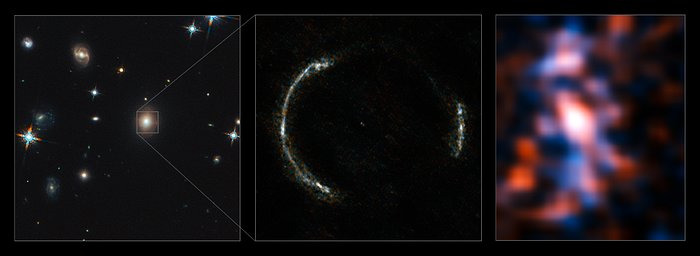Montage of the SDP.81 Einstein Ring and the lensed galaxy (no annotations)
ALMA’s Long Baseline Campaign has produced a spectacularly detailed image of a distant galaxy being gravitationally lensed, revealing star-forming regions — something that has never seen before at this level of detail in a galaxy so remote. The new observations are far more detailed than any previously made of such a distant galaxy, including those made using the NASA/ESA Hubble Space Telescope, and reveal clumps of star formation in the galaxy equivalent to giant versions of the Orion Nebula.
The left panel shows the foreground lensing galaxy (observed with Hubble), and the gravitationally lensed galaxy SDP.81, which forms an almost perfect Einstein Ring, is hardly visible.
The middle image shows the sharp ALMA image of the Einstein ring, with the foreground lensing galaxy being invisible to ALMA. The resulting reconstructed image of the distant galaxy (right) using sophisticated models of the magnifying gravitational lens, reveal fine structures within the ring that have never been seen before: Several dust clouds within the galaxy, which are thought to be giant cold molecular clouds, the birthplaces of stars and planets.
Credit:ALMA (NRAO/ESO/NAOJ)/Y. Tamura (The University of Tokyo)/Mark Swinbank (Durham University)
About the Image
| Id: | eso1522e |
| Type: | Collage |
| Release date: | 8 June 2015, 20:00 |
| Related releases: | eso1522 |
| Size: | 2537 x 928 px |
About the Object
| Name: | Einstein Ring, SDP 81 |
| Type: | Early Universe : Cosmology : Phenomenon : Lensing Early Universe : Galaxy : Type : Gravitationally Lensed |
| Distance: | z=3.04 (redshift) |
| Category: | Galaxies |
Colours & filters
| Band | Telescope |
|---|---|
| Millimeter | Atacama Large Millimeter/submillimeter Array |
